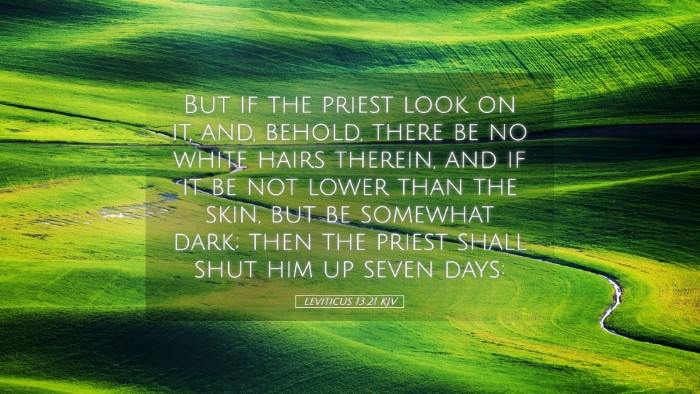Commentary on Leviticus 13:21
Verse Context: Leviticus 13:21 deals with the regulations concerning leprosy and other skin disorders that were prevalent in ancient Israelite society. The verse states: “But if the priest looks at it and indeed, there is no white hair in the bright spot, and it is not deeper than the skin, but has faded, then the priest shall isolate him seven days.” This speaks to the meticulous nature of the laws regarding purity and disease management within the community.
General Insights on Leviticus 13:
The entire chapter provides a detailed guide for priests on how to identify and respond to various skin diseases. It emphasizes the importance of discerning between what is clean and unclean in the eyes of God, symbolizing broader themes of holiness, purity, and community health.
Commentary Highlights:
Matthew Henry's Commentary
Principles of Isolation: Matthew Henry emphasizes that the priest's role is pivotal in maintaining the health of the community. The isolation of individuals shows God's care for both the individual and the community, as it aims to prevent the spread of disease.
Symbolism of Fading: Henry suggests that the fading of the leprous condition may indicate a positive change, symbolizing the idea of hope and healing. He illustrates that God is merciful and gives a chance for recovery, extending grace to those who may be suffering from a spiritual or physical ailment.
Albert Barnes' Notes
Observations by the Priest: Barnes points out that the priest's examination is meticulous, reflecting the seriousness of the obligation to maintain ritual purity. The specifics regarding white hair and the depth of the condition reveal that every part of the human body must be examined for a true diagnosis.
Community Impact: He notes that this process of examination enhances the role of the priest not only as a religious leader but also as a guardian of social health, indicating that spiritual leaders also must care for the physical well-being of their community.
Adam Clarke's Commentary
Understanding Leprosy: Clarke elaborates on the nature of leprosy in the historical context, emphasizing how it was viewed with fear and often led to ostracism. He highlights that the conditions described are not only about physical ailments but address social sin and the need for communal awareness of purity.
Grace Amidst Judgment: Clarke reflects on the period of isolation imposed on the afflicted individual. He interprets this as a form of grace, providing time for reflection and possible redemption, as isolation can be a time of spiritual cleansing and recovery.
Theological Implications:
Holiness and Community: The laws about leprosy teach about the holiness of God and the need for the people to be set apart. The physical separation serves as a reminder of the moral and spiritual separation called for in the community.
- The Nature of Sin: Just as leprosy is a visible sign of decay, so is sin a destructive force in the human condition requiring alertness and remediation.
- Role of the Priesthood: The priest as a mediator is an archetype of Christ, who examines the heart and offers spiritual healing.
Practical Applications:
For Pastors and Leaders: The directives in Leviticus 13 encourage vigilance in spiritual oversight and care within the community. Leaders are reminded to be thorough and compassionate as they guide their congregations toward health and holiness.
- Encourage Accountability: Promote a culture where individuals feel safe sharing their spiritual struggles, much like the requirement for the afflicted to come to the priest.
- Implement Healing Processes: Develop frameworks for healing within the church that encompass spiritual, emotional, and relational dimensions.
Conclusion:
Leviticus 13:21 is a vital part of the narrative presenting the complexities of community health, sin, and the role of spiritual authorities in addressing physical and spiritual ailments. It serves as a reminder that God is both intricate and caring in His calling for purity, utilizing physical ailments to shape internal spiritual realities.
Through the insights of Matthew Henry, Albert Barnes, and Adam Clarke, this verse becomes a rich source of theological reflection, practical wisdom, and compassionate ministry, applicable to the lives of pastors, students, and scholars seeking to understand the implications of holiness in today’s context.


